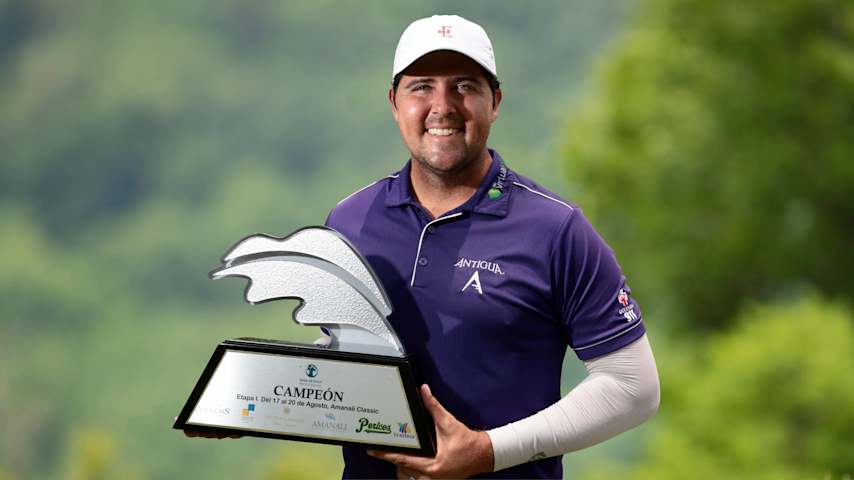Tom Weiskopf’s contributions to the game extended beyond 16 TOUR wins
7 Min Read

Written by Chris Cox
In the early months of 1973, Tom Weiskopf’s schedule was clear. When his time on the golf course came to an end, he’d get in his car to go see his father, Thomas, at the Mayo Clinic.
The two weren’t very close as the younger Tom grew into one of the game’s most recognizable figures. That would suddenly change when the elder Weiskopf developed terminal cancer, a disease which would ultimately claim his life in March of that year. But he didn’t go without one final piece of advice for his son.
“He said, ‘Everybody thinks the world of you, Tom,’” Weiskopf once recalled in an interview with Golf Channel. “’You just don’t believe in yourself. … Just be a little more patient and let it happen. It will come.’”
His father was right. Following his passing, Thomas Weiskopf’s son would put together one of the more remarkable seasons in TOUR history, winning four times, including The Open Championship, when he led wire to wire. He’d go on to win seven more times in his career.
He can finally tell dad all about it now.
Weiskopf—famous early in his career for a classic golf swing, and late in his career for his unforgettable golf course designs—died Saturday, August 20th in Montana at age 79 from pancreatic cancer. He is survived by his wife, Laurie, whom he married in 1999. He has two children—Heidi and Eric—with his first wife, Jeanne. Eric preceded him in death in 2021.
“The PGA TOUR is saddened at the passing of Tom Weiskopf, a towering figure in the game of golf not only during his playing career but through his accomplished work in the broadcast booth and golf course design business,” said PGA TOUR Commissioner Jay Monahan. “Tom is leaving behind a lasting legacy in golf. The beautiful swing he showcased during his 16 career PGA TOUR victories is still being emulated today, while his golf courses remain as testaments to his love for the game. Our hearts and deepest sympathies are with the entire Weiskopf family during this time.”
All told, Weiskopf won 16 times on the PGA TOUR, between 1968 and 1982, no small feat considering the legends of the era, with players like Jack Nicklaus, Johnny Miller and Lee Trevino roaming the fairways. He finished runner-up at the Masters four times—joined only by Ben Hogan and Nicklaus in that category—and tied for second at the 1976 U.S. Open.
But nothing compared to that memorable weekend at Royal Troon Golf Club.
“Even now, I wish my father was alive to see this,” he said after his victory. “I didn’t put out my best in front of him, and doggone it, as long as I’m playing this game I’m going to do my best. I really wanted to win this tournament more than any other major tournament I ever played in.”
Weiskopf never took to the game as a child, despite the pedigree both his father and mother, Eva Shorb, brought to the family. Both had achieved considerable success in the Ohio area, and hoped to pass on their talents to the oldest of their three children. But his passion for the game suddenly changed when Weiskopf’s father took him to the U.S. Open for the first time, in 1957.
“After we walked through the gate, he took me straight to the practice range and pointed out Sam Snead,” he said in the book Chasing Greatness. “The sound of Sam’s iron shots, the flight of the ball, thrilled me. I was hooked even before I started playing.”
His own game took flight from there. He helped guide Benedictine High School to the Cleveland city championship as both a junior and senior in the late 1950s, adding an individual championship the latter year. Those performances were enough to attract the attention of Ohio State coach Bob Kepler, who already had one local Ohio kid on the roster with a decent skillset by the name of Nicklaus.
NCAA rules prohibited him from playing as a freshman—the lone season he would have teamed with Nicklaus for the Buckeyes—but Weiskopf still managed to leave his mark the following season. As a sophomore, he posted the individual low score, 72-76, en route to OSU’s victory in the Ohio Intercollegiate Championship. Weiskopf finished third in the Big Ten Championship a few weeks later.
He left Ohio State not long after, raising money to help earn his way onto the PGA TOUR, where Nicklaus had already become a star. Weiskopf consistently drew comparisons to The Golden Bear, given their Ohio roots and efforts at Ohio State, and Weiskopf earned his share of acclaim during their time competing against one other. Of his 20 all-time PGA TOUR and PGA TOUR Champions wins, Nicklaus finished as the runner-up in four of them.
Even in Weiskopf’s 1973 Open Championship, all eyes centered on Nicklaus at the outset, who needed one more win to break Bobby Jones’ record of 13 major victories. That was, until, his friend and fellow Buckeye stole the show. Nicklaus finished fourth that week.
“Tom Weiskopf had as much talent as any player I’ve ever seen play the TOUR," Nicklaus told Golf Channel.
After his time on the PGA TOUR came to an end, Weiskopf joined the PGA TOUR Champions in 1993 and promptly added another four victories—including the 1995 U.S. Senior Open when he edged Nicklaus by four strokes.
He did it all largely on the strength of his classic golf swing. Renowned golf professional and instructor Bob Toski told the New York Times that Weiskopf’s was “about the best swing in the game.”
Perhaps the highest compliment came from Snead, speaking with a writer in the locker room during the U.S. Open. As told in Chasing Greatness: “Tom Weiskopf. Now, there’s a boy who hits a ton. … He’s longer than Nicklaus. Go watch this boy.’”
Despite that legendary swing, and despite those 28 professional wins, Weiskopf, perhaps, didn’t truly find his calling until after his playing days on the PGA TOUR were over. In 1984, the Massillon, Ohio, native teamed with the late golf course designer Jay Morrish to create Troon North in Scottsdale, Ariz. The rest was history.
“I knew I had to get away from the game for at least a year, so I thought I’d see if I liked architecture,” he recalled to Golf Digest in 2009. “I could still go back on TOUR if I wanted, but I never did.”
Weiskopf also entered the broadcast booth. He was part of the CBS team that called Nicklaus’ historic victory in the 1986 Masters. When asked to give viewers insight into Nicklaus’ thought process over the closing holes, Weiskopf famously replied, “If I knew the way he thought, I would have won this tournament.” Weiskopf later worked for ESPN and ABC, as well.
He found success as both an announcer and architect, bringing his vision to life with such courses as Loch Lomond in Scotland—home for 10 years to the Scottish Open—TPC Scottsdale’s Stadium Course, which has hosted the PGA TOUR’s WM Phoenix Open since 1987, and La Cantera, which was home to the Valero Texas Open from 1995-2009.
Other Weiskopf designs included TPC Craig Ranch (McKinney, Texas), Forest Dunes Golf Club (Roscommon, Mich.), Double Eagle Golf Course (Galena, Ohio), Forest Highlands Golf Club (Flagstaff, Ariz.) and The Ridge at Castle Pines in Colorado.
And, of course, Torrey Pines North—home to not only the TOUR’s Farmers Insurance Open, but the site of Weiskopf’s first professional win on Feb. 11, 1968, where he beat 11-time PGA TOUR winner Al Geiberger by one stroke.
“I look at golf courses a lot of different ways, but I look at the aesthetic course each course can offer,” he said at Torrey Pines in 2017. “You create aesthetic value by having big mature trees, beautiful vista water features and bunker styles. That creates the beauty of the golf course, I think. How could you find a better piece of property than this piece of property, for 36 holes of golf?”
Weiskopf knew the importance of aesthetics, from his eye for scenic property to his elegant golf swing. They both made him a great contributor to the game.






